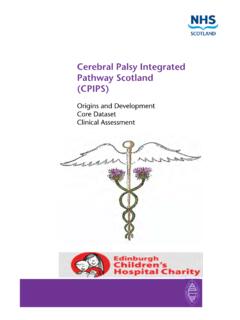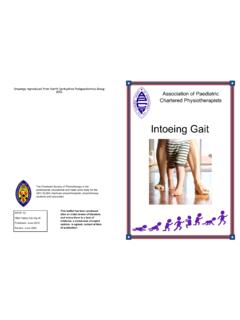Transcription of OBSTETRIC BRACHIAL PLEXUS PALSY: A GUIDE TO …
1 ASSOCIATION OF PAEDIATRICCHARTERED PHYSIOTHERAPISTSOBSTETRIC BRACHIAL PLEXUS PALSY: A GUIDE TO MANAGEMENTASSOCIATION OF PAEDIATRICCHARTERED PHYSIOTHERAPISTSA Professional Network of The Chartered Society of 2012 OBSTETRIC BRACHIAL PLEXUS Palsy A GUIDE to Management ASSOCIATION OF PAEDIATRIC CHARTERED PHYSIOTHERAPISTS Publication date: April 2012 Review date: April 2015 2 3 OBSTETRIC BRACHIAL PLEXUS Palsy A GUIDE to Management Contents Introduction 4 Types of injury, severity, and associated problems and injuries 5 Muscles and segmental information 6 Upper Limb Dermatomes 8 Referral Pathway 9 Assessment of Active Movement 10 Initial Physiotherapy Advice 13 Early Management Guidelines for Parents 15 Range of Motion Exercises for Infants with OBPP 16 Early Management Guidelines for Physiotherapists 21 Other Grading Systems 23 General Information That is Useful When Working in Schools 27 Heading Towards Adolescents 32 Musculoskeletal complications 33 Surgical Procedures 34 References 37 Appendix I: OBPP Passive Range Assessment Chart 39 Appendix II: OBPP Active Movement Assessment Chart 40 4 Introduction The BRACHIAL PLEXUS extends from C5 T1.
2 Most BRACHIAL PLEXUS injuries occur during birth when the complex is put under tension. The aetiology is always a tearing force caused by traction to the head or arm. It may be associated with shoulder dystocia when, following delivery of the head, the anterior shoulder becomes stuck behind the symphysis pubis. There are two basic types of lesion: 1. Large babies (more than 4kg) with vertex presentation and shoulder dystocia who require excess force by traction, often by forceps or ventouse extraction for delivery . This results in upper PLEXUS injury, most commonly to the C5 and C6, and occasionally to the C7 roots, but never the lower nerve roots. 2. breech presentation, usually of small babies (less than 3kg) requiring excessive extension of the head and, often, manipulation of the hand and arm in a fashion that exerts traction on both the upper and lower roots. This may cause rupture or avulsion of any, or occasionally all, of the roots (Gilbert A, 2002).
3 Incidence varies from per 1000 live births (Evans-Jones, 2003) to per 1000 live births (Pondaag et al, 2004). A small proportion of children will sustain bilateral involvement. Rapid return of motor function is a positive sign. Most nerve regrowth and muscle function recovery will occur during the first year. Most babies who spontaneously recover in the early months will have almost full functional recovery, although some residual weakness may remain. 5 Types of injury: an avulsion is when the nerve is torn from where it attaches to the spinal cord - no spontaneous recovery is expected and it is difficult to repair surgically; a rupture is when the nerve is torn - this requires surgery; a neuroma forms when torn nerve fibres have attempted to re-grow and heal themselves, but scar tissue has grown in and around the injury - surgery is needed to remove this; axonotmesis occurs when nerve fibres are ruptured, but the nerve covering is intact - recovery by nerve growth takes time (1mm per day); neuropraxis occurs when the nerve has been damaged but is intact - nerve fibres recover on their own and recovery should occur within 3 months.
4 Severity - will depend on the number of nerves involved and the degree of damage: Erb s Palsy affects C5, C6; upper-middle trunk involves C5, C6, C7; Klumpke s Palsy involves C8, T1; total OBPP affects all levels of the BRACHIAL PLEXUS , C5-T1. Associated problems & injuries: Horner s syndrome ( miosis, ptosis, anhidrosis) - suggesting injury to stellate ganglion; strong association between children with Horner s syndrome and intrinsic hand weakness; clavicular and humeral fractures; torticollis. cephalohaematoma; facial nerve palsy; diaphragmatic paralysis. 6 Muscles and Segmental Information Shoulder Abduction Lateral Rotation Flexion Medial Rotation Extension Adduction Supraspinatus Deltoid Biceps longhead Infraspinatus Teres Minor Deltoid posterior fibres Deltoid - anterior fibres Biceps Pectoralis Major upper fibres Deltoid anterior fibres Pectoralis Major upper fibres Subscapularis Teres Major Latissimus Dorsi Deltoid posterior fibres Teres Major Latissimus Dorsi Triceps long head Biceps short head Pectoralis Major upper fibres Teres Major Coracobrachialis Latissimus Dorsi Pectoralis Major lower fibres Triceps long head C4,5,6 C5,6 C5,6 C(4),5,6 C5,6 C5,6 C5,6 C5,6 C5,6,7 C5,6 C5,6,7 C5,6,7 C5,6,7 C6,7,8 C5,6 C5,6,7 C6,7,8 C(6),7,8,T1 C5,6 C5,6,7 C5,6,7 C6,7 C6,7,8 C(6),7,8,T1 C(6)
5 ,7,8,T1 Elbow Flexion Extension Biceps Brachialis Brachioradialis Extensor Carpi Radialis Longus Pronator Teres Flexor Carpi Radialis Palmaris Longus Flexor Carpi Ulnaris Triceps Anconeus C5,6 C5,6 C5,6 C5,6,7,8 C6,7 C6,7,8 C(6) 7,8,T1 C(6) 7,8,T1 C6,7,8,T1 C7,8 Forearm Supination Pronation Biceps Brachialis Supinator Brachioradialis Pronator Teres Flexor Carpi Radialis C5,6 C5,6 C5,6,7 C5,6 C6,7 C6,7,8 7 Wrist, Fingers & Thumb Extension Flexion Abduction Adduction Extensor Carpi Radialis Longus Extensor Carpi Radialis Brevis Extensor Digitorum Extensor Pollicis Longus Flexor Carpi Radialis Abductor Pollicis Longus Palmaris Longus Flexor Pollicis Longus Flexor Carpi Ulnaris Flexor Digitorum Superficialis Flexor Digitorum Profundus Extensor Carpi Radialis Longus Extensor Carpi Radialis Brevis Flexor Carpi Radialis Extensor Digitorum Abductor Pollicis Longus Extensor Pollicis Brevis Extensor Pollicis Longus Extensor Carpi Ulnaris Flexor Carpi Ulnaris C6,7 C5,6,7,8 C6,7,8 C6,7,8 C6,7,8 C6,7,8 C6,7,8 C6,7,8 C7,8,T1 C7,8,T1 C7,8,T2 C7,8,T1 C6,7,8 C6,7,8 C6,7,8 C6,7,8 C6,7,8 C6,7,8 C6,7,8 C7,8.
6 T1 8 Upper Limb Dermatomes 9 Referral Pathway WITHIN FIRST 24 HOURS FOLLOWING BIRTH ASSESS: Does the baby move both arms equally? Observe spontaneous movements in supine and side-lying; Compare left and right sides; Assess for Horner s sign. If abnormalities observed .. WITHIN 1 WEEK OF RECEIVING REFERRAL: Complete baseline assessment using Toronto scoring; Check passive range of movement; Check parent handling and teach stretches; Provide information on Erbs Palsy Group; Arrange follow-up at 8 weeks or sooner BEFORE DISCHARGE FROM HOSPITAL: X-ray of humerus or clavicle if fractured, arrange pain relief and orthopaedic follow-up; Check for phrenic nerve palsy; Physiotherapy referral for initial advice re. handling and positioning; Refer to paediatric physiotherapy. BY 8 WEEK REVIEW: Refer for specialist opinion if Toronto score < FULL RECOVERY Discharge if full recovery achieved; Goals should focus on minimizing bony deformities and joint contracture, while optimising functional outcomes.
7 INCOMPLETE RECOVERY Continue to monitor active and passive range of movement; Monitor and advise on child s development Refer to Occupational Therapy & Community Paediatrician if appropriate; Advice into school if required; Direct intervention if surgery planned. 10 Assessment of Active Movement Physical examination and other investigations, EMG, are necessary to determine prognosis and the need for operative intervention. It is therefore important to establish a reliable means of classifying upper extremity function in children with BRACHIAL PLEXUS nerve palsy to assist in clinical decisions regarding the need for surgical intervention (Bae et al, 2003; Bialocerkowski and Galae, 2006). Toronto Test Score The Toronto Test Score quantifies upper-extremity function and can be used to predict recovery in infants with BRACHIAL PLEXUS birth palsy. It is designed to predict outcome, and to differentiate between good and poor recovery groups.
8 If the score is less than at 3 months of age, poor recovery is expected. Referral to a tertiary centre is therefore required. This group of children may require early surgical intervention. If the score is greater than , reasonable recovery is likely. Michelow et al (1994) presented this grading system for active joint movements against gravity. The measurements of movements are translated into a 7-point grading system. Active movements are observed of the elbow (flexion/extension), wrist (extension), fingers (extension), and thumb (extension). Each of these five movements are then graded on a scale of 0 (no motion) to 2 (normal full motion), and the sum of the values determines the aggregate, or total, Toronto Test Score (maximum 10 points).. Muscle Grade Numerical Score Gravity Eliminated No Contraction 0 0 Contraction, no motion 1 Motion < range 2 Motion > range 3 Full motion 4 Against Gravity Motion < range 5 Motion > range 6 Full motion 7 2 11 Active Movement Scale (AMS) The Active Movement Scale (AMS) documents upper extremity function during treatment and/or recovery (Bialocerkowski and Galae, 2006).
9 Clarke and Curtis developed this system to produce the AMS (Curtis, 2002), in which movements against gravity and movements independent of gravity are included. With this scale, each of fifteen different active upper extremity movements are tested, first with gravity eliminated and then against gravity. Each movement is scored on a scale of 0 to 7. The AMS is very comprehensive and tests muscle groups controlled by the entire BRACHIAL PLEXUS . Scores are given for each of the following joint movements: shoulder flexion, shoulder abduction, shoulder adduction, shoulder internal rotation, shoulder external rotation, elbow flexion, elbow extension, forearm pronation, forearm supination, wrist flexion, wrist extension, finger flexion, finger extension, thumb flexion, and thumb extension. Ensure the movement is gleno-humeral, not shoulder girdle, when assessing shoulder movement and strength Hospital for Sick Children Active Movement Scale Score Gravity Eliminated No contraction 0 Contraction, no motion 1 <50% range of motion 2 >50% range of motion 3 Full motion 4 Against Gravity <50% range of motion 5 >50% range of motion 6 Full motion 7 12 The Medical Research Council (MRC) scale for muscle strength This can also be used to grade muscle strength and is based on the child s effort on a scale of 0-5.
10 Grade 0 - no action discernible in the muscle at all Grade 1 - a twitch as the muscle undergoes a small contraction but is not strong enough to perform any of its specified joint movement. Grade 2 - a muscle strong enough to perform its designated joint movement when the force of gravity is eliminated, making it much easier to perform. Grade 3 - a muscle strong enough to perform the joint action to the full range against gravity but with no resistance applied. Grade 4/5 - a muscle can move the joint through the full movement both against gravity and against some resistance. See Appendices 1 and 2 for assessment charts 13 Initial Physiotherapy Advice Positioning and handling Parents should be advised to: touch and gently move their baby s arm; not pull on the affected arm, nor lift under the armpits when lifting their baby; and to ensure that the arm is well supported with the shoulder, elbow, wrist and hand in a neutral position wrapping the baby in a blanket when moving may make handling easier in the early weeks; keep their baby s arm close to its side, or in a forward position when holding or feeding; support their baby s arm with a rolled up towel to keep that arm in a neutral position when the baby is lying on its back; start with their baby s affected arm first when dressing, and when undressing to start with the unaffected arm.


